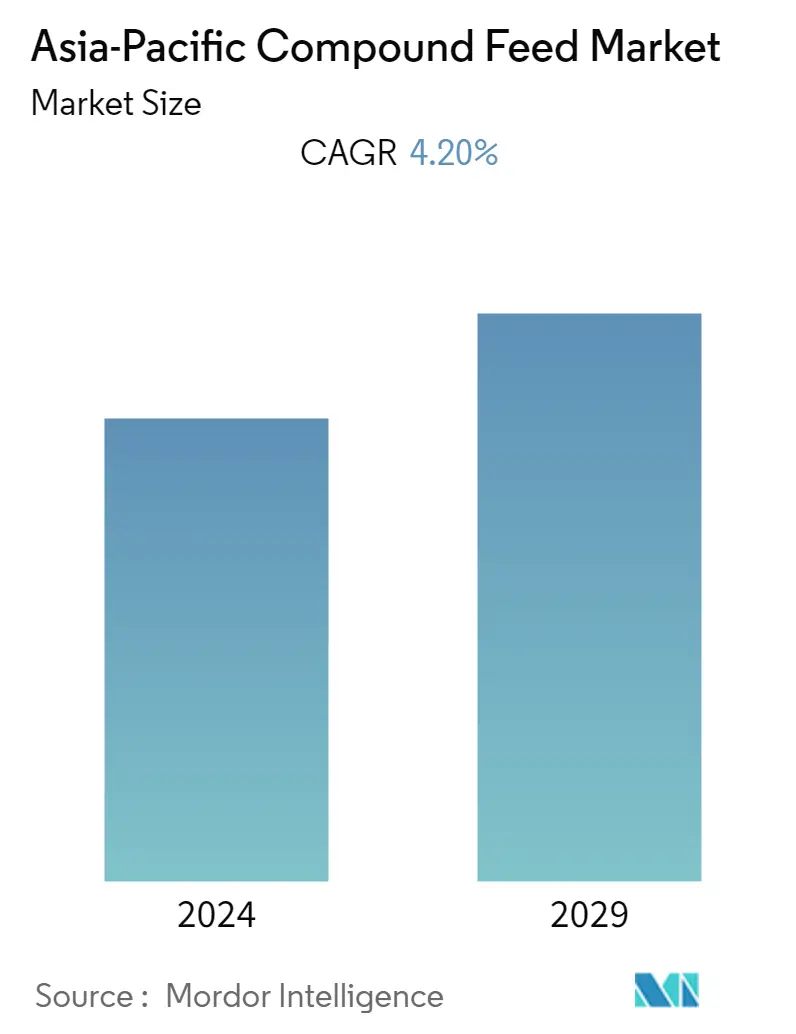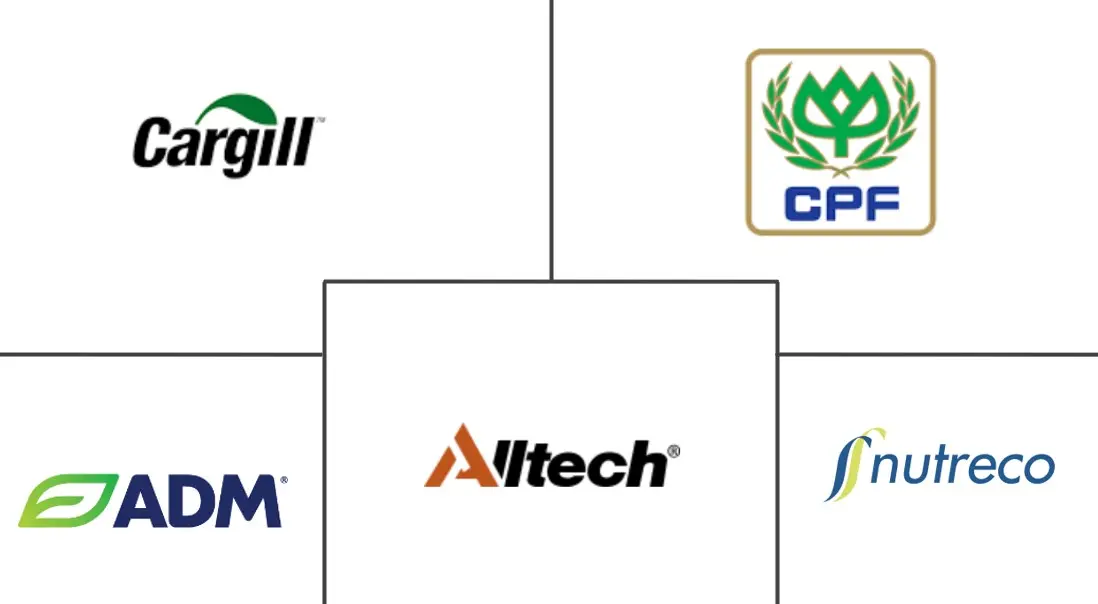Market Size of Asia-Pacific Compound Feed Industry

| Study Period | 2019 - 2029 |
| Base Year For Estimation | 2023 |
| Forecast Data Period | 2024 - 2029 |
| Historical Data Period | 2019 - 2022 |
| CAGR | 4.20 % |
| Market Concentration | Low |
Major Players
*Disclaimer: Major Players sorted in no particular order |
Asia Pacific Compound Feed Market Analysis
The Asia-Pacific compound feed market is estimated to register a CAGR of 4.2% during the forecast period.
- Asia-Pacific accounted for the most extensive market and is anticipated to remain the leading consumer of compound feed in the coming years. Increasing incomes, high meat consumption, and high meat production are responsible for the region's dominance. China, Vietnam, Malesia, India, and Indonesia are the major compound feed consumers in the region.
- China and India are this region's leading markets, contributing a major part to the growing demand. China is one of the largest compound feed manufacturers in the world, accounting for half of the production in this region.
- The growing concern for the well-being of animals and government initiatives drive the Asian compound feed market. Despite this, the easy availability of raw materials, and quality control, fluctuating prices are major constraints to the compound feed market.
Asia Pacific Compound Feed Industry Segmentation
Compound feed is fodder, which is made by blending several raw materials and additives. These are fed to livestock and aquatic animals.
The Asia Pacific compound feed market report is segmented by ingredients (cereals, oilseeds, oil, molasses, and supplements), supplements (vitamins, amino acids, antibiotics, enzymes, antioxidants, acidifiers, and probiotics & prebiotics), animal type (ruminant, swine, poultry, aquatic, and other types), and geography (China, India, Thailand, Japan, South Korea, and Australia).
The market offers market size in terms of value in USD million.
| Ingredients | |
| Cereals | |
| Oilseeds | |
| Oil | |
| Molases | |
| Supplemets | |
| Other Ingredients |
| Supplements | |
| Vitamins | |
| Amino Acids | |
| Antibiotics | |
| Enzymes | |
| Antioxidants | |
| Acidifiers | |
| Prebiotics and Probiotics | |
| Other Supplements |
| Animal Types | |
| Ruminant Feed | |
| Swine Feed | |
| Poultry Feed | |
| Aquatic Feed | |
| Other Animal Types |
| Geography | |
| China | |
| India | |
| Japan | |
| Thailand | |
| Vietnam | |
| Australia | |
| Rest of Asia Pacific |
Asia-Pacific Compound Feed Market Size Summary
The Asia-Pacific compound feed market is poised for steady growth, driven by increasing incomes and a rising demand for meat protein across the region. This market is characterized by its extensive scale, with China, Vietnam, Malaysia, India, and Indonesia being the primary consumers. The region's dominance is further bolstered by China's position as a leading manufacturer of compound feed, contributing significantly to the global supply. The livestock industry, a crucial component of agricultural development in Asia, has seen remarkable growth, supporting the surging demand for livestock products. Despite challenges such as fluctuating raw material prices and quality control issues, government initiatives and a growing focus on animal well-being are propelling the market forward.
The demand for compound feed is expected to rise, fueled by the increasing meat production and consumption in countries like India, China, and Thailand. The presence of large-scale poultry farms and a growing animal population in China are key factors driving this demand. The market is fragmented, with major players like Cargill Inc., Charoen Pokphand Foods, and Archer Daniels Midland Company holding significant but small shares. These companies are actively expanding their production capacities and geographic presence through acquisitions and strategic investments. Recent developments, such as ADM Animal Nutrition's acquisition of a feed mill in the Philippines and the establishment of a flavor production facility in China, highlight the ongoing efforts to meet the region's demand for innovative and high-quality animal nutrition products.
Asia-Pacific Compound Feed Market Size - Table of Contents
-
1. MARKET DYNAMICS
-
1.1 Market Overview
-
1.2 Market Drivers
-
1.3 Market Restraints
-
1.4 Porter's Five Forces Analysis
-
1.4.1 Threat of New Entrants
-
1.4.2 Bargaining Power of Consumers
-
1.4.3 Bargaining Power of Suppliers
-
1.4.4 Threat of Substitute Products
-
1.4.5 Intensity of Competitive Rivalry
-
-
-
2. MARKET SEGMENTATION
-
2.1 Ingredients
-
2.1.1 Cereals
-
2.1.2 Oilseeds
-
2.1.3 Oil
-
2.1.4 Molases
-
2.1.5 Supplemets
-
2.1.6 Other Ingredients
-
-
2.2 Supplements
-
2.2.1 Vitamins
-
2.2.2 Amino Acids
-
2.2.3 Antibiotics
-
2.2.4 Enzymes
-
2.2.5 Antioxidants
-
2.2.6 Acidifiers
-
2.2.7 Prebiotics and Probiotics
-
2.2.8 Other Supplements
-
-
2.3 Animal Types
-
2.3.1 Ruminant Feed
-
2.3.2 Swine Feed
-
2.3.3 Poultry Feed
-
2.3.4 Aquatic Feed
-
2.3.5 Other Animal Types
-
-
2.4 Geography
-
2.4.1 China
-
2.4.2 India
-
2.4.3 Japan
-
2.4.4 Thailand
-
2.4.5 Vietnam
-
2.4.6 Australia
-
2.4.7 Rest of Asia Pacific
-
-
Asia-Pacific Compound Feed Market Size FAQs
What is the current Asia-Pacific Compound Feed Market size?
The Asia-Pacific Compound Feed Market is projected to register a CAGR of 4.20% during the forecast period (2024-2029)
Who are the key players in Asia-Pacific Compound Feed Market?
Cargill Inc., Charoen Pokphand Foods, ADM Animal Nutrition, Alltech Inc. and Nutreco are the major companies operating in the Asia-Pacific Compound Feed Market.

